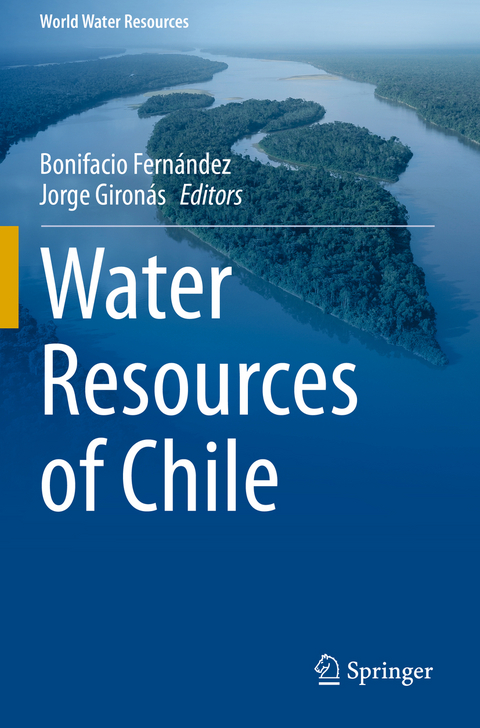
Water Resources of Chile
Springer International Publishing (Verlag)
978-3-030-56903-7 (ISBN)
Chile is a privileged country in terms of water resources, with an average annual runoff of approximately 50,000 m3/person. However, water availability varies enormously in space, as less than 1,000 m3/person are available for more than 50% of the population. The temporal and spatial distribution of water resources is driven by processes highly variables across a country with different climates explained not only by a large range of latitudes (from 17° to 56° south), but also the presence of the Pacific Ocean and the Andes with peaks up to 7000 m. This geography makes of Chile a true natural laboratory in which water is essential for the society and the economy of the country. The relevance of water resources for the country has become even more significant in the context of a mega-drought that has affected practically the entire territory in recent years, although large floods such as those in Atacama 2015 and 2017 also take place periodically.
This unique book brings together the state-of-art knowledge about the hydrology of Chile and its water resources, with a particular focus on quantitative aspects. The chapters are prepared by many of the most relevant researchers and practitioners working in water resources in the country. High-quality research contributions on climate and meteorology, surface and subsurface hydrology, water quality, water monitoring, water resource and global change, among other issues, are presented in this unique book, which offers a useful guide for academicians, researchers, practitioners and managers dealing with diverse water-related issues in Chile and other regions with similar characteristics
lt;p>Bonifacio Fernández is a Civil Engineer from the Pontificia Universidad Católica de Chile (PUC) and has both a MSc and PhD degree from the Colorado State University obtained in 1982 and 1984 respectively. Since 1973, he is a faculty in the Departamento de Ingeniería Hidráulica y Ambiental at PUC, and became Emeritus Professor in 2014. He has been Visiting Professor at the Universidad Politécnica de Valencia, Spain, and Colorado State University, where he was Affiliatte Faculty between 2002 and 2013. He was president of the Chilean Society of Hydraulic Engineering and is currently one of its Honorary Directors. Its main areas of interest are in stochastic hydrology, models for the analysis and study of drought, and the estimation of risk and the probability of occurrence of complex hydrological phenomena. He is also a specialist in urban drainage, and is the main author of the 'Chilean Urban Drainage Manual' (2013, Ministerio de Obras Públicas, in Spanish) and a 'Design Guide for Stormwater Management'. He has taught undergraduate and graduate courses, and is the author of a book on Fluid Mechanics published in Chile and Mexico, and the chapter on drought characterization in the recently published second edition of the 'Handbook of Applied Hydrology' (2016, McGraw-Hill).
Jorge Gironás holds a MS degree in Civil Engineering from the Pontificia Universidad Católica de Chile (PUC), and a PhD from the Colorado State University. Currently, he is faculty in the Departamento de Ingeniería Hidráulica y Ambiental at PUC, where he teaches undergraduate and graduate courses in hydrology and water systems. His main area of research is in hydrology and water resources, with specific interests in urban hydrology, stormwater modeling, basin morphology, extreme events and climate change. Dr. Gironás has led several research projects and participated in multiple interdisciplinary initiatives held, among others, by the Centro de Desarrollo Urbano Sustentable, the Centro de Investigación para la Gestión Integrada del Riesgo de Desastres, and the Centro Interdisciplinario de Cambio Global UC. Recently he has been working in hydrologic modeling for early warning systems and hydrologic assessment of green infrastructure in urban settings. In addition to more than 60 peer-reviewed papers, he is the main author of the EPA-SWMM model application's manual (2009, U.S. Environmental Protection Agency), and co-author of the Chilean Urban Drainage Manual (2013, Ministerio de Obras Públicas, in Spanish) and the chapter on drought characterization in the second edition of the 'Handbook of Applied Hydrology' (2016, McGraw-Hill).
Foreword.- Chapter 1: Country profile.- Chapter 2: Climate and Weather in Chile.- Chapter 3: Precipitation, temperature and evaporation.- Chapter 4: Surface Water Resources.- Chapter 5: Groundwater resources.- Chapter 6: Snow cover and glaciers.- Chapter 7: Extreme Events, floods.- Chapter 8: Extreme Events, droughts.- Chapter 9: Catchment-Scale Natural Water Balance in Chile.- Chapter 10: Water Quality.- Chapter 11: River Basin Policy and Management.- Chapter 12: Agricultural Uses.- Chapter 13: Domestic uses of Water.- Chapter 14: Mining and Industrial Uses.- Chapter 15: Hydroelectric Uses.- Chapter 16: The Chilean forest sector and its relationship with water resources.- Chapter 17: Environmental and recreational uses.- Chapter 18: Economics of water resources.- Chapter 19: Impacts of Climate Change on Water Resources.- Chapter 20: Impacts of Urbanization and Land Use Change over Water Resources.- Chapter 21: Water Resources Research in Chile.- Chapter 22: Challenges for thefuture.
| Erscheinungsdatum | 05.12.2021 |
|---|---|
| Reihe/Serie | World Water Resources |
| Zusatzinfo | XVIII, 433 p. 136 illus., 110 illus. in color. |
| Verlagsort | Cham |
| Sprache | englisch |
| Maße | 155 x 235 mm |
| Gewicht | 688 g |
| Themenwelt | Naturwissenschaften ► Geowissenschaften ► Geologie |
| Naturwissenschaften ► Geowissenschaften ► Hydrologie / Ozeanografie | |
| Schlagworte | Chile Climate and Weather • Climate change impacts • Climatology in Chile • Extreme events • Groundwater of Chile • hydrogeology • Hydrology of Chile • meteorology • Meteorology of Chile • River Basin Management • Rivers in Chile • Snow Cover and Glaciers • Surface Water Resources • Water Management and Politics • Water Policy • water quality • water resources • watershed • Water Uses • World Regional Geography |
| ISBN-10 | 3-030-56903-9 / 3030569039 |
| ISBN-13 | 978-3-030-56903-7 / 9783030569037 |
| Zustand | Neuware |
| Haben Sie eine Frage zum Produkt? |
aus dem Bereich


